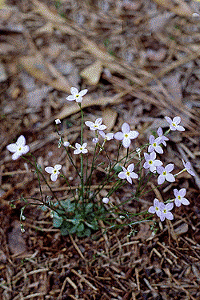
 Look for these tiny delicate but colorful blossoms in lawns, clearings, and forest margins, in March and April. The corolla is a narrow tube crowned by four lobes spreading sharply at right angles, about one-half inch across. The species name means "sky blue" and the flowers are often that color; but they may be a clear white, or shades of blue and lilac. The "eye" is a bright yellow.
Look for these tiny delicate but colorful blossoms in lawns, clearings, and forest margins, in March and April. The corolla is a narrow tube crowned by four lobes spreading sharply at right angles, about one-half inch across. The species name means "sky blue" and the flowers are often that color; but they may be a clear white, or shades of blue and lilac. The "eye" is a bright yellow.The tiny perennial plants grow only about six inches tall and are often much shorter. The flowering stems arise in tufts from slender rhizomes, with a rosette of tiny leaves at the base, and even smaller leaves in pairs on the stems. Each stem ends in a single flower.
These flowers are among those which botanists term dimorphous (meaning occurring in two forms) and refers to the stamens and pistils. These vary in size, some flowers having a tall pistil and short stamens, others short pistil and tall stamens. The blossoms with the tall pistils must be fertilized with pollen from the tall stamens, and the short pistils are only acted upon by the short stamens. Thus fertile seeds are produced only by cross-pollination between plants with different style lengths. This is one of nature's interesting safegards against self-pollination.
Bluets are also called Innocence or Quaker-ladies. They are common and easily transplanted.
Another species is Houstonia pusilla, called Small Bluets or Star Violets. It is one of the more common harbingers of spring. This annual species is similar to the above, but the corolla is often one-half the size, colored a deep blue-purple, with a darker or "red eye".
